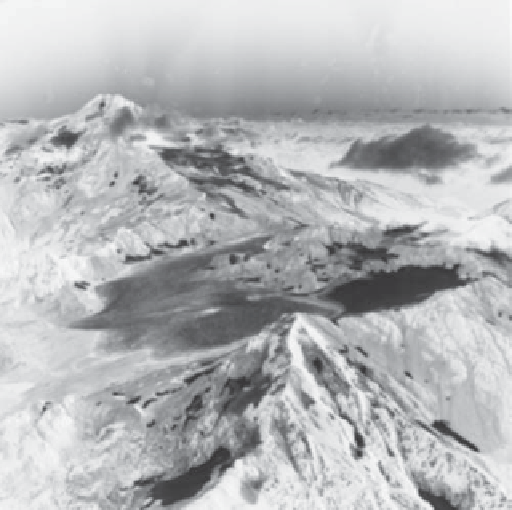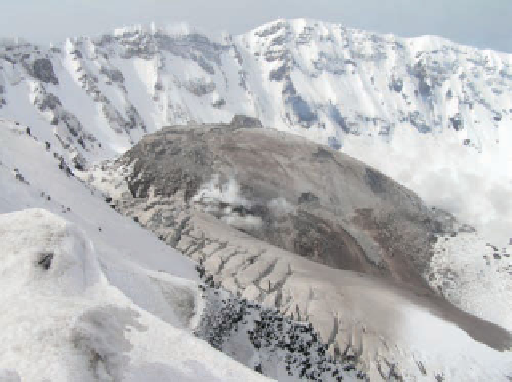Geology Reference
In-Depth Information
4.8 km
2
, but a rapid episode of retreat
began in 1930 and now it covers only
about 0.9 km
2
and has thinned to about
35 m thick. In fact, by 2002, the glacier's
northern branch was gone, and what
had been an ice-fi lled valley is now
fi lled with rubble. The south branch
may persist for a few more decades, but
it, too, is retreating and thinning.
◗
Figure 1
View of a lava dome and the newly formed glacier in
the crater of Mount St. Helens on April 19, 2005. Notice the ash
on the surface of the glacier, which also shows large crevasses.
◗
Figure 2
Whitechuck Glacier on Glacier Peak in Washington
State. The south branch of the glacier on the right has a small
accumulation area, but the north branch has none.
northern end of the Antarctic Peninsula broke apart and
several ice streams from the Antarctic ice sheet surged to-
ward the ocean.
During a surge, a glacier may advance several tens
of meters per day for weeks or months and then return
to its normal fl ow rate. Surging glaciers constitute only a
tiny proportion of all glaciers, and none of these are in the
United States outside of Alaska. Even in Canada, they are
found only in the Yukon Territory and the Queen Elizabeth
Islands.
The fastest glacial surge ever recorded was in 1953
in the Kutiah Glacier in Pakistan; the glacier advanced
12 km in three months, for an average daily rate of about
130 m. In 1986 the terminus of the Hubbard Glacier in
Alaska began advancing at about 10 m per day, and in 1993
Alaska's Bering Glacier advanced more than 1.5 km in just
three weeks.
The onset of a glacial surge is heralded by a thick-
ened bulge in the upper part of a glacier that begins to
move toward the terminus at several times the glacier's
normal velocity. When the bulge reaches the terminus, it
causes rapid movement and displacement of the termi-
nus by as much as 20 km. Surges are also probably related
to accelerated rates of basal slip rather than more rapid
plastic fl ow. One theory holds that thickening in the zone
of accumulation with concurrent thinning in the zone
of wastage increases the glacier's slope and accounts for
accelerated fl ow. But another theory holds that pressure on



Search WWH ::

Custom Search